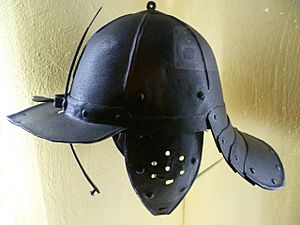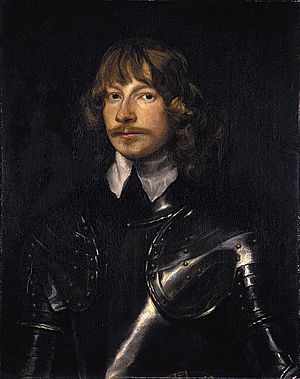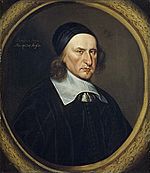Engagers facts for kids
Quick facts for kids
The Engagers
|
|
|---|---|

A Covenanter's helmet from the period in the Museum of Edinburgh
|
|
| Founded | December 1647 |
| Dissolved | 1651 |
| Split from | Covenanters |
| Religion | Presbyterianism (Church of Scotland) |
The Engagers were a group of Scottish Covenanters during the 1600s. They made a special agreement, called "The Engagement", with King Charles I of England in December 1647. At this time, King Charles was a prisoner of the English Parliamentarians after losing the First English Civil War. The Engagers wanted to help the King get his power back in England.
Contents
Understanding the Engagers' Story

In the 1600s, politics and religion were very closely linked. To understand groups like the Engagers, Royalists, or the Kirk Party, you need to know about their religious differences. These differences often shaped their political ideas.
Church Leadership: Bishops vs. Elders
The words 'Presbyterian' and 'Episcopalian' described how a church was run. They were not about what people believed. Episcopalian churches were led by bishops. These bishops were chosen by the king. Presbyterian churches were controlled by Elders. These Elders were chosen by their local church members.
Arguments about church structure were also about who had power. Was it the king or the church members? This was a big reason for political disagreements.
Scotland's Church and the King
The Protestant Reformation led to the creation of the Church of Scotland. This church, also called the 'kirk', was Presbyterian. It followed the teachings of Calvin. When James VI and I became King of England in 1603, he wanted to unite the churches. He dreamed of one strong country with one church led by bishops.
However, the Scottish and English churches were very different. Even Scottish bishops thought many English church practices were too much like Catholicism.

King Charles I of England tried to make everyone follow the same church rules. This led to the 1638 National Covenant. People who signed it promised to resist these new rules. In December 1638, bishops were removed from the kirk. Charles tried to use his army, but he lost the 1639 and 1640 Bishops' Wars. This left the Covenanter party in charge of Scotland.
Covenanters and the King's Power
Most Covenanters believed that a king was part of God's plan. They thought monarchy was divinely ordered. However, they disagreed on who should have the final say in church matters. Royalists and Engagers usually thought the king had the most power. But their reasons were complex. Many people, like Montrose, fought for both the Covenanters and the King at different times.
When the First English Civil War began in 1642, Scotland stayed neutral at first. But then Scotland got involved in the Irish Rebellion of 1641. This conflict made people's views in Scotland and Ireland much stronger. The Covenanter group called the Kirk Party, led by Argyll, believed that uniting the churches with England was the best way to keep the Presbyterian kirk safe. In October 1643, they signed the Solemn League and Covenant. This agreement promised a Presbyterian union in return for Scotland's military help.
Royalists and moderate groups in both Scotland and England were against this union. So were religious Independents, like Oliver Cromwell. Cromwell's New Model Army was very powerful. He did not want any church to be controlled by the state. Both the Covenanters and their English allies saw the Independents as a bigger threat than the Royalists. When King Charles surrendered in 1646, they started talking about putting him back on the English throne.
The Engagement Agreement
The Scots sent three representatives to talk with King Charles. These were Lauderdale, Lanark, and Loudoun. In December 1647, Charles agreed to make Presbyterianism the main religion in England for three years. He also promised to stop the Independents. But he refused to sign the Covenant himself. This caused a split among the Scots.
It took until April 1648 for the Engagers to get a majority in the Parliament of Scotland. Argyll's Kirk Party did not trust King Charles. They also did not like the idea of joining forces with English and Scottish Royalists. They called the Engagement 'sinful'.
Preparing for Battle
Most of the Scottish army had been sent home. Efforts to recruit new soldiers were difficult. Many people refused to join, including their most experienced generals, Lord Leven and David Leslie. The inexperienced Duke of Hamilton was put in charge. The Earl of Callendar was his second-in-command. Callendar had often disagreed with Lord Leven in the past. He thought he was a better soldier than he was. This caused problems with Hamilton too. His infantry commander, William Baillie, knew the New Model Army well. He doubted they could win against it.
After scattering Kirk Party members at Mauchline Muir in June 1648, a poorly trained Engager army of 9,000 marched into England. The Second English Civil War was supposed to be a series of Royalist uprisings in England and Wales. The Scots were meant to support them. But by the time Hamilton's army reached Lancashire in early August, the other revolts had been stopped. Cromwell's army completely defeated the Engagers at Preston on August 19. Hamilton was captured and executed in March 1649.
What Happened Next
The defeat at Preston caused the Engager government to fall apart. The Kirk Party took control of Edinburgh. They were stopped at Stirling in September. But it looked like a new civil war was about to begin. However, with Cromwell's help, Argyll took control. He removed his Engager opponents from power. The English troops then left Scotland.
The 1649 Act of Classes stopped Engagers and Royalists from holding political or military jobs. It made the Kirk Party the official government of Scotland. But the execution of King Charles in January 1649 was seen by Covenanters as a terrible act against God. They declared his son, Charles II, King of Scotland and Great Britain. In the 1650 Treaty of Breda, they agreed to help Charles get the English throne back. In return, he accepted the Covenant. But defeats at Dunbar and Worcester meant Scotland became part of the Commonwealth of England, Scotland and Ireland in 1654.


